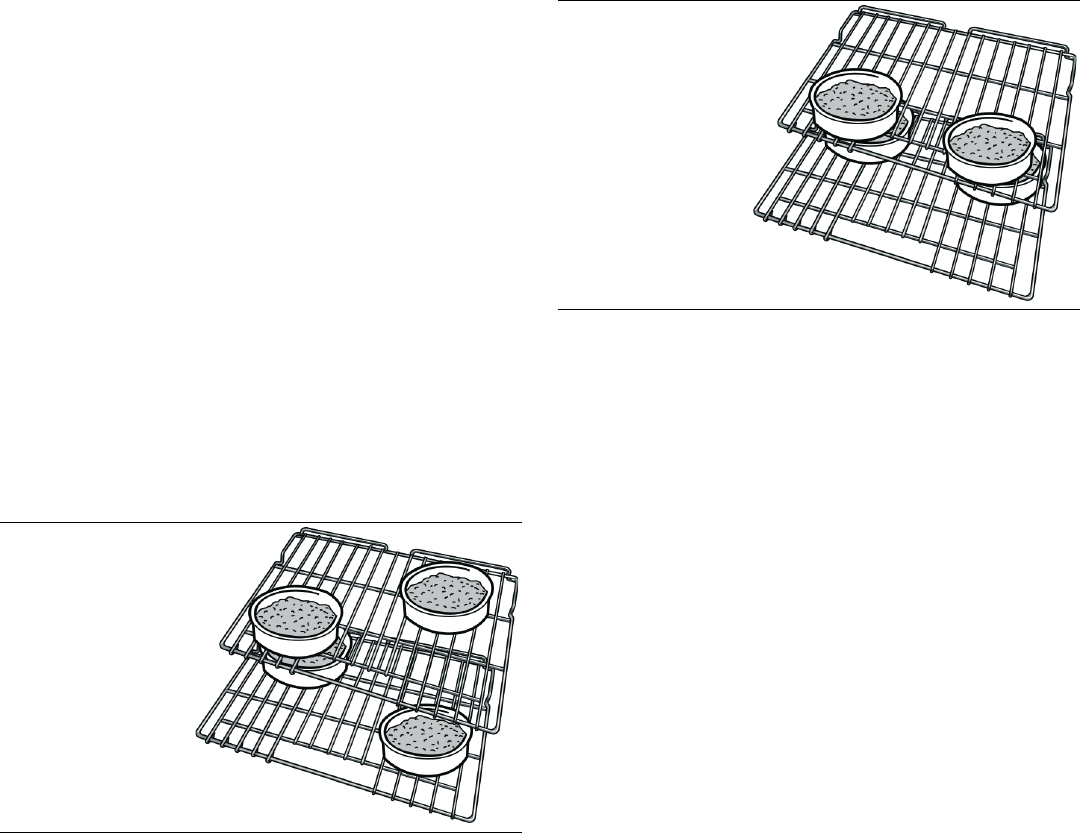
18
Bake %
Bake is cooking with dry, heated air. Both the upper and
lower elements cycle to maintain the oven temperature.
The Bake mode can be used to prepare a variety of food
items, from pastries to casseroles. Refer to recipe or
package directions for oven temperature and baking
time.
Tips
▯ Preheat the oven if the recipe recommends it.
▯ Baking time will vary with the size, shape and finish of
the bakeware. Dark metal pans or nonstick coatings
will cook faster with darker results. Insulated bakeware
will lengthen the cook time for most foods.
▯ For best results, bake food on a single rack with at
least 1-1
^” space between pans or dishes and oven
walls.
▯ Eliminate heat loss from the oven by using the window
to periodically check food for doneness instead of
opening the door.
▯ If multiple racks are necessary, use a maximum of 2
racks. For cakes use rack positions 2 and 5, for
cookies use rack positions 1 and 4. Stagger pans so
that one is not directly above the other (see graphic
below). See “Pan Placement“ under “General Tips“ for
more information. You may also consider using a
convection mode.
Convection Bake (Some Models) 2
Convection Bake is similar to Bake. Heat comes from the
upper and lower heating elements. The main difference
in convection baking is that the heat is circulated
throughout the appliance by the convection fan.
The Convection Bake mode is well suited for cakes, bar
cookies and breads to take advantage of the bottom
heat, yielding a better crust on baked items. The benefits
of Convection Bake include:
▯ Slight decrease in cook time.
▯ Higher volume (yeast items rise higher).
Tips
▯ Reduce recipe temperature by 25 °F. Refer to the
cooking chart at end of this manual.
▯ Place food in shallow, uncovered pans, such as
cookie sheets without sides.
▯ If baking more than one pan on a rack, allow at least
1-1
^“ of air space around the pan.
▯ For cakes use rack positions 2 and 5. Stagger pans
so that one is not directly above the other (see
following graphic).
True Convection :
True Convection cooks with heat from a third element
behind the back wall of the oven. The heat is circulated
throughout the oven by the convection fan.
True Convection is well suited for cooking individual
serving-sized foods such as cookies and biscuits. It is
also good for cooking on multiple racks (2 or 3) at the
same time. Baking cookies is possible on 6 racks
simultaneously. In this case, the baking time increases
slightly. The benefits of True Convection include:
▯ Even browning.
▯ Time savings as a result of using multiple racks at one
time.
Tips
▯ Reduce recipe temperature by 25 °F. Refer to chart at
end of the manual.
▯ Place food in low-sided, uncovered pans such as
cookie sheets without sides.
▯ If baking more than one pan on a rack, allow at least
1“ to 1
^“ of air space around the pan.
Roast %
Roast uses both the upper and lower elements to
maintain the oven temperature. Roasting uses more
intense heat from the upper element than the lower
element. This results in more browning of the exterior
while the inside remains especially moist.
Roast is best suited for large cuts of meat and poultry.
Tips
▯ Use a high-sided broil pan, or cover dish with a lid or
foil.
▯ Add liquids, such as water, juice, wine, bouillon or
stock for flavor and moisture.
▯ Roasting bags are suitable for use in this mode.
▯ When roasting whole chicken or turkey, tuck wings
behind back and loosely tie legs wih kitchen string.
Pan stagger in
Bake mode for
30” appliances.
Pan stagger in
Convection Bake
mode for
30” appliances.


















